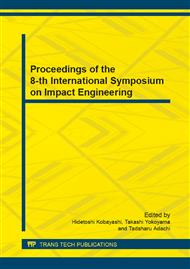p.505
p.511
p.517
p.525
p.530
p.536
p.542
p.548
p.554
Development of an Output-Bar Supporting Stand to Suppress Transverse Vibration in Dynamic Tensile Test of Sheet Steel
Abstract:
In the one bar method, one of the standardized high velocity tensile testing techniques for thin steel plate, sometimes it shows an apparent effect of transverse vibration of an output bar on dynamic behavior of the plate. Suppressing the lateral vibration of the loading end of the bar is the most important factor to decrease the apparent effect, as pointed by Yoshida, Kuriyama, Uenishi and Takahashi in 2002, and the present author in 2011. He proposed an output-bar supporting technique with a polytetrafluoroethylene (PTFE) collar. In the former work, the lateral vibration was not fully suppressed, because the collar had some clearance to the output bar. He convinced that, in order to eliminate the clearance, it was worthy to give some transverse pre-load on the bar from the outer surface of the collar. However, the output bar is a load-sensing elastic body with strain gages adhered on it. The axial strain signal is a source of load detection. If such transverse compression is applied to the output bar, the axial skin strain of it is reduced to some extent. The key factor is the collar material, PTFE. This solid polymer possesses the lowest coefficient of friction in the situation of PTFE on steel, typically 0.05-0.10. The present author has modified an output-bar supporting stand to apply the lateral compressive load to the output bar with the divided PTFE collars which allow the smooth axial movement of the bar. The transverse compressive load is varied as 0, 70, 200 and 420 N. Obtained dynamic stress-strain curves at the strain rate of 500 s-1 are compared each other to indicate the effect of the lateral compression on the bar. As a result, the lateral compression of 200 N is found as the most suitable condition.
Info:
Periodical:
Pages:
530-535
Citation:
Online since:
June 2014
Authors:
Price:
Сopyright:
© 2014 Trans Tech Publications Ltd. All Rights Reserved
Share:
Citation:


